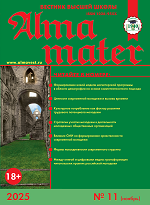UDC 37.09:373::62
https://doi.org/10.20339/AM.01-20.016
D.P. Danilaev is Dr.Sci. (Engineering), doc. e-mail: danilaev.reku@kstu-kai.ru; and N.N. Malivanov is Dr.Sci. (Pedagogy), prof., head of sub-faculty e-mail: cno@kai.ru
at Kazan National Research Technical University n.a. A.N. Tupolev (KNITU-KAI)
Analyzed is one of strategic objective of education, i.e. preparing children for life in high-tech competitive world. Additional educational system offers various concepts and forms of children’s education. Popular areas of education are highlighted. These are robotics, aircraft modeling, programming, electronics. However, proposed programs are rarely related. Accumulated experience allows to go to the system construction of schoolchildren technical education. The purpose of the article is to analyze possible tasks and structure of this system.The use of the competency-based approach in education led to the system formation of continuing professional education and integration of general education systems, secondary vocational and higher education. Real integration has actualized the search for relevant pedagogical approaches and models for additional technical education organizing. There has been a transition from the diagnosis of schoolchildren abilities and inclinations to environment formation of professional self-determination and children development, personality self-realization, and their social identity organization. Approaches to such system construction depend on conditions for educational programs’ implementation. It should be taken into account adequacy of number, qualifications, competence of teachers, material and technical base, methodological developments availability, funding sources and so on. The general goal of additional technical education could be diversified into private goals, with which teaching methods are determined. A system structuring option and methods for integrating technical education programs with basic general education programs are determined in connection with diversified goals. Diversification of schoolchildren technical education goals allows a multi-level system implementation of additional technical education. Its phased construction is possible.
Keywords: additional education of schoolchildren, technological education, technical education system, engineering lyceums.
References
1. Shestakova, I.G. New temporality of digital civilization: future is already come. Scientific technical notes SPbGPU. 2010. No. 2. P. 20–29.
2. Andreeva, N.V., Rozhdestvenskaya, L.V., Yakhramov, B.B. Step of school in mixed education. Moscow, 2016.
3. Barber, M., Murshed, M. How get stable high quality education at schools. Lessons of analysis of best systems of school education of the world. Problemsofeducation. 2008. No. 3. P. 7–60.
4. Borisenkov, V.P. Quality of education and problems of training pedagogical cadres. Educationandscience. 2015. No. 3. P. 4–18.
5. Fradkin, V.E. Problems of school natural sciences education. URL: https://newtonew.com/school/problems-school-science-education
6. Shigareva, E.N. Perspective directions of professional orientation of schoolpersons in the system of additional technological education. VestnikofVyatkastateuniversity. 2012. No. 3-3. P. 51–55.
7. Molokov, D.S. Foreign experience of granting services in the sphere of additional education for children. Yaroslavl pedagogical vestnik. 2013. No. 1. P. 225–231.
8. Sean, Brophy, Stacy, Klein, Merredith, Portsmore, Chris, Rogers. Advancing engineering education in P-12 classrooms. Journal of Engineering Education. 2008. July. P. 369–387.
9. How organized is the system of education in various countries of the world. URL: http://www.online812.ru/2011/03/23/003/
10. Asmolov, A.G. How project universal educational actions at elementary school: from action to thought. Moscow, 2008.
11. Psychological encyclopedia. URL: http://gufo.me/psy_a
12. Tsuckerman, G.A. Formation of educational activity in collective dissimilated form. Moscow, 1980.
13. Zimnyaya, I.A. Personal activity approach as base of organization of educational process. URL: http://psychlib.ru/mgppu/ZOsv-01/ZLD-244.HTM#
14. Simonova, G.I. Activity approach to pedagogical accompaniment of social adaptation of schoolchildren. Vestnik of Vyatka state university. 2012. No. 3-3. P. 59–64.
15. Bazhin, K.S., Simonova, G.I., Khodyreva, E.A. Art and technical creativity in the eyes of young scientists: analysis of results of research. Vestnik of Vyatka state university. 2012. No. 3-3. P. 51–55.
16. Nelyubov, S.A. On the concept of school engineering education. URL: http://www.minobr.nso.ru/sites/minobr.nso.ru/wodby_files/files/wiki/2014...











.png)






